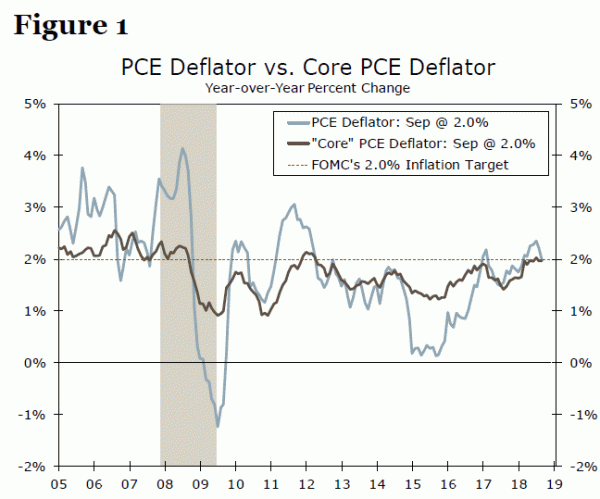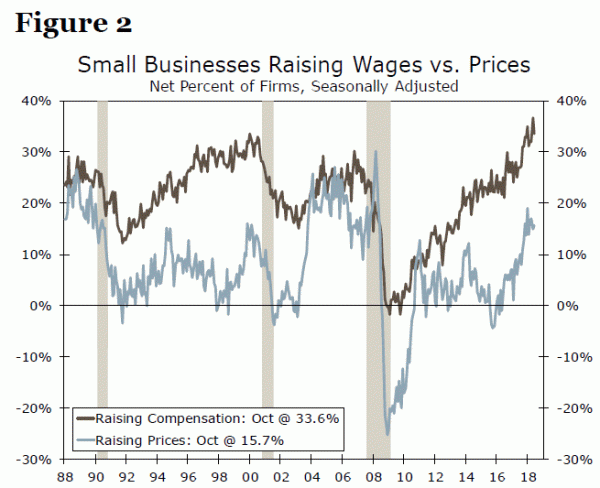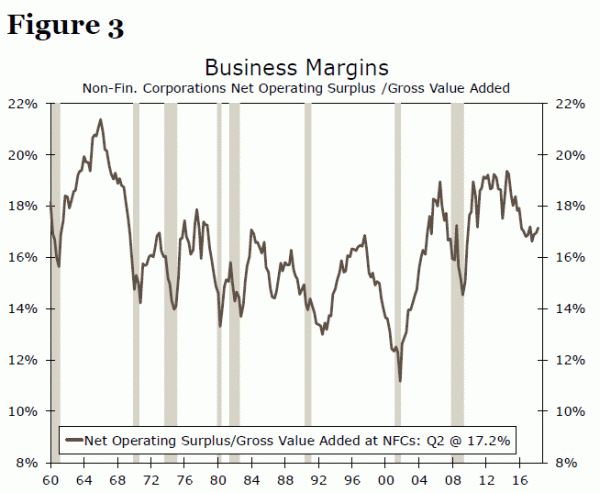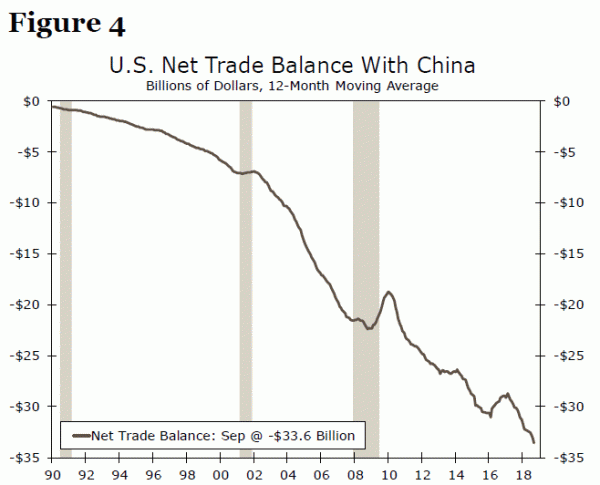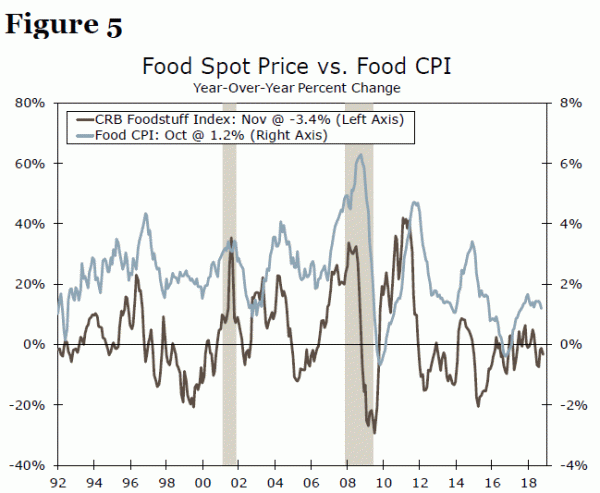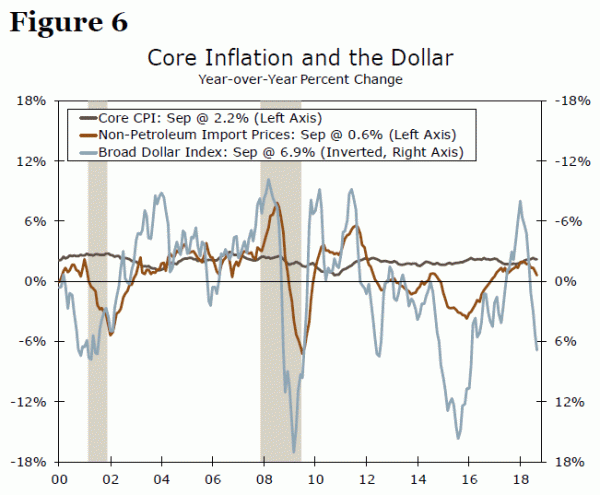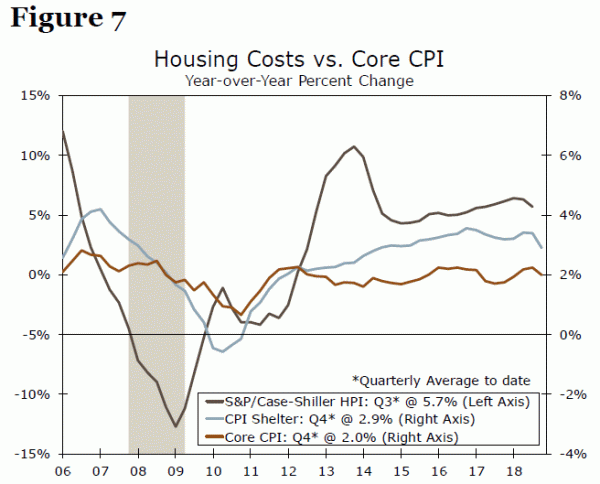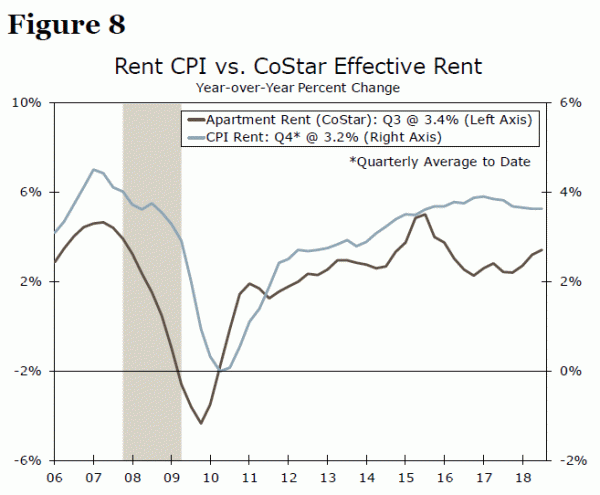Not Too Hot, Not Too Cold but Just Right
Inflation has reached a Goldilocks state as far as the Fed is concerned. Both headline and core PCE inflation are up 2.0% over the past year, exactly in line with the FOMC’s target. That follows six years in which the core—the FOMC’s preferred barometer of trend inflation—undershot the committee’s goal. Multiple bouts of disinflation, like in 2015 and again in 2017, had many questioning whether the Fed’s 2% goal was achievable (Figure 1). The FOMC pressed ahead with normalizing anyway, but at a historically slow rate. Further tightening has continued on gradually as inflation has firmed without showing signs of becoming unhinged. Yet could the Goldilocks scenario change and cause the Fed to either quicken its pace of policy tightening or ease up on the brakes?
In a report last year, we focused on five specific inflation surprises for the upcoming year. This year, we take a more thematic approach and look at the factors we view as most likely to lead inflation away from its current sweet spot of 2.0%. While we see a number of scenarios that would cause inflation to veer either above or below 2%, we believe that ultimately, solid U.S. growth and upward pressures from tariffs will push core PCE inflation to 2.2%. That would be moderate enough to where the Fed is likely to hike a few more times next year. But where might things go wrong?
Upside Risk I: Capacity Constraints Come to a Boil
The United States is on course for one of, if not the, best years of the current expansion. Strong growth alone is not sufficient for inflation, but 2018’s solid performance registers at a time when there is very little excess capacity in the economy. Given inflation’s tendency to lag growth, the economy’s impressive performance this year may only now be starting to rev up inflation.
Capacity constraints are particularly evident in the labor market, where the unemployment rate is already below “full employment.” Job openings are near record highs, while finding qualified labor is small businesses’ single most important problem. Wages are rising as a result. While still modest compared to the later stages of previous cycles, research suggests that the relationship between unemployment and wages is nonlinear.1
The pass-through between wage costs and inflation may not be as strong as it once was2, but there is still a positive link between a tight labor market and inflation. Labor is the largest cost for most companies, particularly in the service sector, which accounts for 75% percent of core inflation. With order books full and companies seeing take-home pays rise as they cut bigger checks to their employees, businesses may be emboldened to raise prices. The share of businesses that is raising compensation and prices has jumped over the past year to the highest level of the expansion (Figure 2).
The tighter labor market and increased willingness for firms to raise prices is part of our baseline call for modestly higher inflation next year, but a steepening of the Phillips Curve and/or faster tightening in the labor market may lead inflation to rise more strongly. That could lead the FOMC to tighten rates faster and/or more than the three quarterly 25 bps hikes in our current forecast.
Upside Risk II: Tariff Trouble
Labor costs are not the only thing pressuring business profits and prompting firms to raise prices. Tariffs on about $300 billion worth of goods are pushing up production costs for U.S. firms and allowing others to raise prices. Even though goods account for only 25% of the core CPI index, we estimate that the tariffs that have been put in place by the Trump administration thus far will add approximately a couple tenths to inflation.
More tariffs, however, may very well be in store. Not only are tariffs on $200 billion of imports from China set to jump from 10% to 25% at the start of the year, but the administration has threatened 25% tariffs on remaining imports from China, worth about an additional $267 billion. While talks between the United States and China look poised to resume, there are major grievances regarding China’s trade practices that make a quick fix look difficult.
In an environment where margins are already coming under pressure as labor costs rise, there may be little scope for firms to absorb prices (Figure 3). The reduction in corporate tax rates may have given firms some cushion in 2018, but tougher base comparisons for 2019 profit growth may lead firms to finally pass on related costs. Retaliatory tariffs that depress prices at home for U.S. goods will provide at least some offset. However, at the end of the day, the United States still runs a trade deficit with China, leading to more imports exposed to tariffs (Figure 4). Retaliatory tariffs from all countries have been placed on about $135 billion worth of U.S. goods this year versus the $300 billion in tariffs on imports.
Were the trade spat to deepen, or extend to more countries, inflation is likely to rise more than we currently forecast. While that may erode real household income and investment returns, the Fed would likely look through the increase since it is likely to be a one-time level shift in prices. The risk, however, is that the proliferation of tariffs would cause inflation expectations to become unmoored, generating the need for the Fed to react to the higher path of inflation.
Downside Risk I: Slower Global Growth Overrides U.S. Strength
An escalating trade war brings us to our first downside risk. The trade battle with the United States may already be taking a toll on growth in China. Third quarter GDP slowed more than expected, coming in at 6.5% year-over-year, while other measures of activity have also cooled. That has begun to weigh on many of the country’s other trading partners. Pared-back expectations for global growth have hit commodity prices. Oil has tumbled more than 20% since early October, while spot prices for industrial metals have fallen since the summer. At the same time, declining agricultural prices point to pressure on consumer food inflation in the year ahead (Figure 5).
Commodity prices have been pressured not only by a deteriorating outlook for global demand, but by the unwavering strength of the dollar. We expect the dollar to edge lower in early 2019. That call is contingent on growth and monetary policy beginning to converge between the U.S. and other major economies. If that dynamic takes more time, the dollar and commodity prices would put ontarget inflation in jeopardy.
If headline inflation were to fall below target because of declining prices for energy and food commodities, the FOMC would likely be unfazed. In the short-run, energy and agricultural prices are less influenced by monetary policy than by politics and weather. The bigger risk for Fed policy is if moves in commodity prices and the dollar are sharp enough to filter into core inflation. Yet there is only a very small link between core inflation and the price of oil or the value of the dollar (Figure 6).3 The effects of oil and the dollar are primarily concentrated in the goods portion of core inflation, which, as we previously mentioned, is only 25% of the index. As a result, it would take some fairly big moves in commodity prices and the dollar to move core inflation enough for the Fed to rethink its policy path.
Downside Risk II: Just as Other Sectors Heat Up, Housing Cools
Most areas of the U.S. economy have boomed this year with one notable exception: housing. Affordability concerns have come to the forefront after years of prices outpacing income growth. The affordability challenge has grown more acute this past year as mortgage rates have jumped by about 100 bps. Home sales have fallen over the past six months as a result, and price growth is beginning to moderate. That could spell trouble for inflation. Shelter accounts for just over 40% of core CPI and almost 20% of core PCE. Not only is housing a sizeable portion of inflation indices, but it has consistently risen faster than overall inflation (Figure 7). If the softness in home prices filters into the CPI, the inflationary pressure from a “hot” economy elsewhere might not be enough to offset weakening in such a juggernaut.
The largest part of the shelter index, the imputed rent of owner-occupied homes, is derived from asking homeowners how much they think their home would rent for in the current market. The shelter component therefore lags sales-based measures of home prices by about 18 months. As such, we believe softening home prices won’t be a problem for official inflation in 2019 as much as it will be in 2020. At the same time, the price of rented housing has been growing at a fairly steady rate and suggests that that fraction of shelter should hold up (Figure 8). A weakening in prices or faster pass-through to inflation, however, is not out of the question.
Will the Inflation Bears Return Home in 2019?
With recent economic developments pointing toward both U.S. and global growth slowing in the year ahead, concerns have reemerged about the FOMC maintaining its inflation target. The sharp decline in oil prices over the past month has lowered expectations for headline inflation next year. It has also raised concerns about core inflation wobbling as it did in 2015. Oil, however, is down a little less than 30% from its recent peak compared to a 60% year-over-year decline at the worst of the 2014-2016 oil rout. The price break that falling oil prices offers to transport-related costs for core goods and services is also likely to be offset by worker shortages in the sector that have pushed up labor costs.
The recent strength of the dollar points to more tepid inflation, all else equal, again similar to 2015. The increase in the dollar over the past year, however, has been more moderate than at the height of the 2014-2015 run-up, even if on a level basis the dollar’s value is close to a 16-year high. At the same time, cheaper import prices due to the stronger dollar will at least in part be negated by tariffs raising the costs of some imported items and their domestically-produced alternatives.
On net, we see core inflation drifting higher in the year ahead. Solid economic growth this past year when labor availability and capacity has become constrained is likely to be still filtering through to inflation. Tariffs are pressuring costs for some businesses and giving firms a clear reason to raise prices. Barring a significant escalation in trade disputes, the pickup in inflation should remain fairly modest, however. Inflation expectations have remained little changed over the past few years, which suggests that price increases are likely to be restrained. The pullback in commodity prices, a strong dollar, retaliatory tariffs and the housing slowdown are also expected to keep domestic inflation pressures from generating a clear breakout in inflation. Therefore, while core inflation is likely to stray a bit above the FOMC’s target in 2019, we expect the committee to slowly raise rates a few more times next year. There are plenty of risks around inflation, however, that could lead the Fed to change course.
1 Nalewaik, Jeremy. (2016). “Non-linear Phillips Curves with Inflation Regime Switching.” Finance and Economics Discussion Series, Divisions of Research & Statistics and Monetary Affairs, Federal Reserve Board, Washington, D.C. 2016-078.
2 Peneva, Ekaterina V. and Jeremy B. Rudd (2015). “The Passthrough of Labor Costs to Price Inflation,” Finance and Economics Discussion Series 2015-042. Washington: Board of Governors of the Federal Reserve System, http://dx.doi.org/10.17016/FEDS.2015.042.
3 See “Do Oil and Dollar Effect Core Inflation?” Apr. 27, 2015, available on request.




